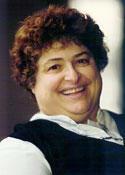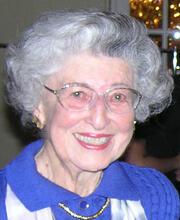Libbie Henrietta Hyman
Libbie Henrietta Hyman in 1941.
Courtesy of the Smithsonian Institution/Wikimedia Commons.
Libbie Henrietta Hyman spent her career researching and writing the definitive texts on invertebrates, a monumental effort. Hyman began her career as a botanist, but upon encountering anti-Semitism, she changed her focus to zoology, earning her PhD from the University of Chicago in 1915. She became a research assistant under Charles Manning Child, publishing forty articles and two books on invertebrates in sixteen years. The proceeds from her books were enough to allow her to focus on pure research, inspiring her to move to New York in 1931. Between 1940 and 1967, Hyman published her six-volume treatise, The Invertebrates, as well as ninety articles, despite struggling with Parkinson’s. Hyman won numerous accolades, and her works continue to be cited and used today.
Article
In 1960, zoologist Libbie Hyman explained her work: “I like invertebrates. I don’t mean worms particularly, although a worm can be almost anything, including the larva of a beautiful butterfly. But I do like the soft delicate ones, the jellyfishes and corals and the beautiful microscopic organisms.” Hyman transformed her love of the soft creatures to writings that brought her international recognition as an expert on invertebrates and as the world authority on flatworms.
Libbie Henrietta Hyman was born December 6, 1888, in Des Moines, Iowa, to Jewish immigrant parents, Joseph and Sabina (Neumann) Hyman. She had one younger and two older brothers. Her father was born in Russian Poland, while her mother came from Stettin, Germany. Joseph Hyman was an unsuccessful clothing retailer, and the family was poor.
Hyman grew up in Fort Dodge, Iowa, where she was valedictorian of her high school graduating class in 1905. She entered the University of Chicago in 1906 and began her studies in botany, but left that department when she encountered antisemitism. She moved into zoology, her lifetime field of work.
After receiving a B.A. in 1910 and a Ph.D. in 1915, she became research assistant to Professor Charles Manning Child, under whom she had studied. For the next sixteen years, she worked with Child on his studies of lower invertebrates and published more than forty research articles. Hyman also wrote two laboratory manuals that made a major impact on her career path. The Laboratory Manual for Elementary Zoology was published in 1919 and revised in 1929, while the Laboratory Manual for Comparative Vertebrate Anatomy also went through two editions, in 1922 and 1942.
Hyman found that she could live on the income from royalties on the two manuals and left Chicago in 1931, when Child was nearing retirement. She decided to devote herself full time to preparing a treatise on invertebrates and moved to New York City to use the library at the American Museum of Natural History. In 1937, she became an honorary research associate at the museum, an unpaid position that provided office and laboratory space. She devoted most of her time to study, with little socializing or leisure activity. Between 1940 and 1967, Hyman published the six-volume work The Invertebrates, as well as some ninety articles.
Hyman’s work was recognized from the start as outstanding. In 1941, the University of Chicago gave her an honorary Sc.D.; in 1960, the Linnaean Society of London awarded her its Gold Medal in Zoology.
Hyman developed Parkinson’s disease during the 1950s but continued her long work days. She was in a wheelchair, under the care of a nurse, when she completed the sixth volume of The Invertebrates. The museum honored her with a Gold Medal Award for Distinguished Achievement in Science in April 1969, just four months before her death on August 3. Although Hyman had no ties with the Jewish community, she bequeathed one thousand dollars to the Federation of Jewish Philanthropies of New York.
Libbie Henrietta Hyman was a major contributor to the field of zoology. Her publications have continued to be cited and used. The Invertebrates is still considered a masterly source.
Selected Works by Libbie Henrietta Hyman:
The Invertebrates. 6 vols. (1940–1967).
Laboratory Manual for Comparative Vertebrate Anatomy (1922). Revised as Comparative Vertebrate Anatomy (1942).
Laboratory Manual for Elementary Zoology (1919. Revised 1929).
“Hyman, Libbie Henrietta.” In Women Building Chicago 1790–1990: A Biographical Dictionary, ed. Rima Lunin Schultz and Adele Hast (2001).
National Academy of Sciences, Biographical Memoirs (1991) (www.biodiversity.uno.edu/~worms/bio/hyman.html) Contains autobiography and evaluation by G. Evelyn Hutchinson; BEOAJ; Blackwelder, Richard E. “Libbie H. Hyman Memorial Issue: Her Life.” Journal of Biological Psychology 12 (1970): 4–12.
Division of Invertebrate Zoologists Newsletter (Fall 1991).
Emerson, William K. “Bibliography of Libbie H. Hyman.” In Biology of the Turbellaria, edited by Nathan W. Riser and M. Patricia Morse (1974).
Linnaean Society of London. Proceedings of the Linnaean Society of London 172 (1961): 162–163.
NAW modern.
NYTimes, August 5, 1969, 37:1.
Stunkard, Horace W. “In Memoriam Libbie Henrietta Hyman, 1888–1969.” In Biology of the Turbellaria, edited by Nathan W. Riser and M. Patricia Morse (1974).
UJE.
WWIAJ (1928, 1938).
WWWIA 4.
Yost, Edna. American Women of Science (1943).














